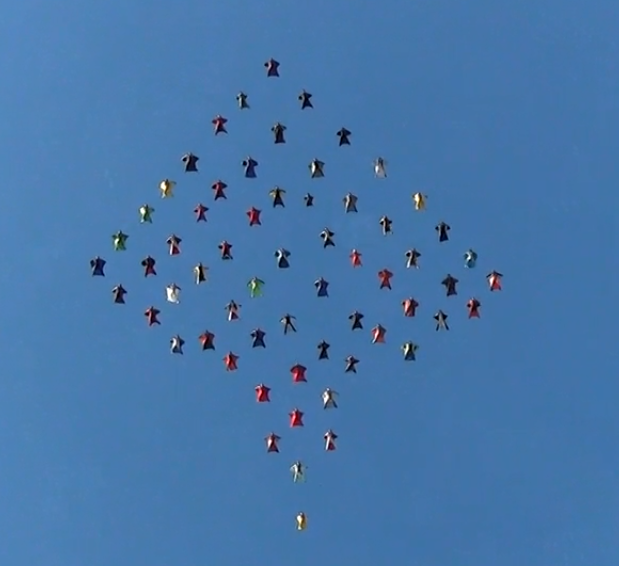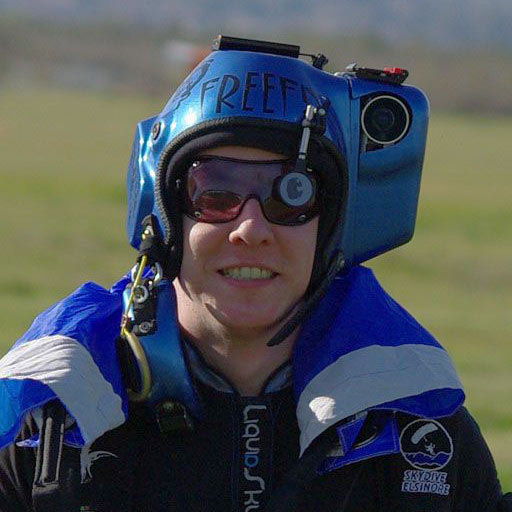Recommended Posts
kallend 2,231
Quote
I also suspect that kicking does nothing - you have nothing to kick against, which means your displacement at the end of the action should be 0. You can't contort yourself in such a way as to cause translation unless you're in a heavily curved section of space-time, such as near a black hole for an object human-sized. :).
Not correct. If you kick appropriately you generate angular momentum in your legs which has to be balanced by opposite angular momentum in your torso.
According to your theory a highboard diver could never generate a twisting dive, and a cat not could turn over and land on its feet if dropped upside down.
The only sure way to survive a canopy collision is not to have one.
Quote
If you kick appropriately you generate angular momentum in your legs which has to be balanced by opposite angular momentum in your torso.
Right, which means you don't actually end up spinning at all, you just contort in an amusing manner.
Quote
According to your theory a highboard diver could never generate a twisting dive, and a cat not could turn over and land on its feet if dropped upside down.
A diver (and a cat) can only change the direction and speed of the rotation they have upon leaving the diving board. At all times (assuming they aren't going fast enough to use the wind) they must conserve angular momentum. If dropped with no rotation whatsoever, the most skilled diver in the world would be powerless to rotate until they caught some wind. Likewise, if you dropped a cat perfectly evenly with its back to the ground, it would not land on its feet.
In the diver's case, the appropriate rotation is gained from the diving platform, and the cat relies on the complex, chaotic nature of the universe to insure that it will have some angular momentum to work with when it falls off things. :)
Now, if you had a fast canopy, you might be able to help yourself by sticking alternating arms out, much like doing a barrel roll in freefall.
QuoteA diver (and a cat) can only change the direction and speed of the rotation they have upon leaving the diving board.
Then how does a diver increase his speed, stop the twist, go from a tuck to a pike position? How does a gymnast do all the movement during a floor exercise?
I think you might want to reconsider John’s explanation of angular momentum, he might know something about physics.
Sparky
skyrider 0
QuoteQuoteA diver (and a cat) can only change the direction and speed of the rotation they have upon leaving the diving board.
Then how does a diver increase his speed, stop the twist, go from a tuck to a pike position? How does a gymnast do all the movement during a floor exercise?
I think you might want to reconsider John’s explanation of angular momentum, he might know something about physics.
Sparky
That was so much better worded, than how I was going to bitch slap them!
Quote
Then how does a diver increase his speed,
By reducing the average distance of his mass from the axis of rotation, the speed of his rotation increases. This is a cool little demonstration:
http://www.youtube.com/watch?v=yAWLLo5cyfE
Another excellent visual is the ice skater:
http://www.youtube.com/watch?v=AQLtcEAG9v0
EDIT: it's due to the conservation of angular momentum, basically the same as "an object at rest tends to stay at rest, and an object in motion tends to stay in motion, unless acted upon by an outside force."
Quotestop the twist, go from a tuck to a pike position?
Like I said, the direction can be changed, but not the magnitude. So a diver can translate a twist into a flip and vice verse (to a large extent), and even slow rotation down enough (by spreading out) to appear stopped - usually just before entry into the water. Starting a dive with a good amount of angular momentum gives the diver a lot of freedom to perform a great deal of spinning.
That said, it *is* actually possible to do a torqueless, zero angular momentum twist or flip (i was wrong about the cat being dropped perfectly above), but it requires a significantly more complicated motion than kicking, since you are forced to maintain 0 angular momentum throughout the move. Moreover, once you've done it, you stop. You can't start a spin that continues on its own from a state of rest with nothing to push off.
Maybe there is a maneuver which could untwist a line twist slightly, however i think your time could be better spent getting into a position which allows the canopy to do the work.
Here's a good read: http://docs.google.com/viewer?a=v&q=cache:2kcSiyZlrG0J:www.physics.princeton.edu/~mcdonald/examples/mechanics/frohlich_ajp_47_583_79.pdf+conservation+of+angular+momentum+diving&hl=en&gl=us&pid=bl&srcid=ADGEESizuxBm6G5gZlEWXaXgvzRbmC3IuHichDOoPB6soC71Jmby_4McbIjfojI8IvWjTVWM6ao_egPNg-SCXVkG8APoVYY7cyWTi8umvMAd4ZrJkCJ4JTJsJJ9bWEQCaQmrLZAm-m0R&sig=AHIEtbRkYXpryv9CzaL7l7gUYDiE97xjbg
EDIT: since I can't put an addendum on my first post above: The post states that it's not possible to rotate or translate on flat space-time. This is apparently not *entirely* correct. You can apparently reposition yourself, however you still cannot introduce a sustained spin, nor can you translate.
You can still swim through curved space, though, if you're interested in getting up close and personal with a black hole.
billvon 3,179
>it would not land on its feet.
Actually it would. It 'spins' its hindquarters to generate torque and uses that torque to rotate itself. Cats pretty much always land on their feet as long as they have time to rotate around (i.e. they need a half a second or so to get their feet under them.) It's the same basic way that reaction wheels work on spacecraft.
Ronaldo 0
I totally agree with you that kicking alone doesn’t do much help for untwisting. What usually happens is that when you start kicking you grab the risers and exert a counteracting torque on them with your body. This is what undoes the twist. Although the parachute has a relatively low mass it is flying and this flight gives it a lot of “dynamic” inertia (it resists to changes in motion).
Try this experiment: sit in an office chair (spin type with good bearings) and lift your feet off the floor. Now try to rotate yourself kicking your legs, arms, whatever you want, you’ll remain facing the same direction. Now put one finger on the desk and push (apply torque). The desk is the parachute, you need this link to create torque and have something happening. Also, to create torque you need a lever and this is probably why untwisting the risers works well. In the above video you can see that when the twists reach the links the risers are allowed to separate. At this moment you have a lever arm (spread risers) and it is exactly when the parachute spins the jumper.
When you don’t bring the twists down you don’t have a good lever to create torque and untwisting takes longer.
It is also interesting to see that the parachute keeps flying in the same direction, it is the jumper that spins which means that although the jumper has a higher mass the parachute has a much higher overall inertia (at this axis).
Who doesn’t love Physics?![]()
I am going to have to spend some time on a trampoline experimenting with these fancy maneuvers, though.
Ronaldo: I totally agree. The video trevor posted was very impressive, and makes me want to try that technique. I would *love* to find something which I feel actually works to speed the naturally progression of the line twist.
kallend 2,231
Whatever you say, Chief.![]()
The only sure way to survive a canopy collision is not to have one.
champu 1
QuoteIt's the same basic way that reaction wheels work on spacecraft.
Reaction wheels?!? Old hat, man.
But speaking of spacecraft, the segment starting at 3:10 in this video seems apt to this discussion.
That's a very cool clip. Thanks!
I wonder how much torque you can apply to something that way. I mean, you have to expend some energy to do it, so presumably you could apply some torque, even if it's not much.
For the apparent he achieved, I can only assume he was swimming. ![]()
Inspired 0
QuoteBy adding energy to an object in motion, you can, in fact, change its angular momentum.
Not without an external force. It is not possible to change the angular momentum of a free body by applying only internal stresses. Read the paper[link] I posted up there on the topic.
QuoteKicking adds energy.
Technically kicking would remove energy from the system, by converting some stored energy into heat which would then be radiated away. You could use that heat to power a radio or something, but without any mass to eject (or something to kick against) it would just be squandered as you cool down. You might even be able to move a tiny bit by the directed emission of electromagnetic radiation from said radio, but you can rest assured the effect would be minuscule.
My last post was supposed to say "For the apparent translation he achieved". I assume he's swimming through the air he's breathing, since again it's impossible to translate without ejecting mass or suffering an external force.
There is the caveat to those that it is possible in curved space time[link], which technically the spacemonkey in the video is in, however the effectiveness is determined by the *amount* of curvature. You can tell it's not curved very much because you don't feel like gravity is constantly attempting to pull your arms off.
A quote from the paper I just linked: " The curvature of space-time is very slight, so the ability to swim in space-time is unlikely to lead to new propulsion devices. For a meter sized object performing meter sized deformations at the surface of the earth the displacement is of the order 10^-23 meters. "





.thumb.jpg.4bb795e2eaf21b8b300039a5e1ec7f92.jpg)



When we were taught to spread the risers during AFF, it immediately struck me as an odd, counter-intuitive idea.
Think about it as if you just have a weight hanging from two strings. You don't pull the strings apart at the bottom, shuffling the twists upwards - that just makes the system tighter. You pull the strings apart above the twists - that gets the weight spinning quickly and easily.
I also suspect that kicking does nothing - you have nothing to kick against, which means your displacement at the end of the action should be 0. You can't contort yourself in such a way as to cause translation or change in momentum unless you're in a heavily curved section of space-time, such as near a black hole for an object human-sized. :)
Moreover, I've had two linetwists severe enough to need work, and neither time did I feel that my actions did anything to speed up the natural progression of the twist - and I typically have a extremely good feel for that sort of thing.
EDIT: also, sorry about the apparent necropost - I've actually had a couple conversations about this issue recently and wanted to throw my $.02 in.
Share this post
Link to post
Share on other sites